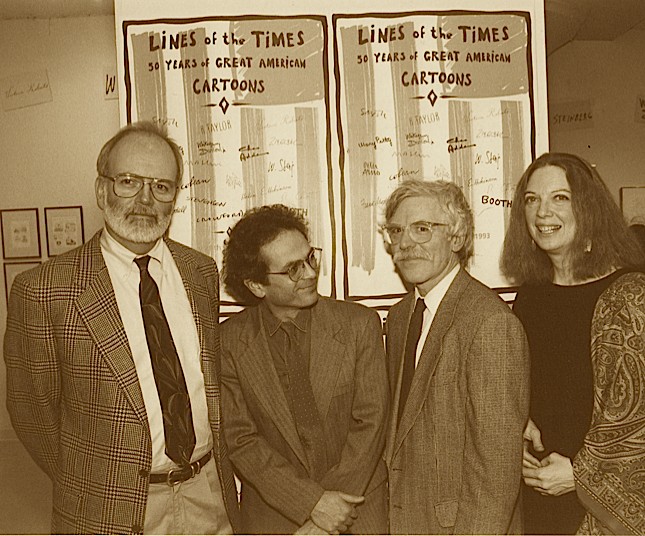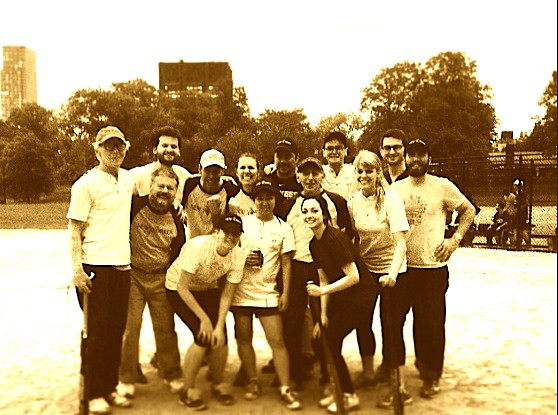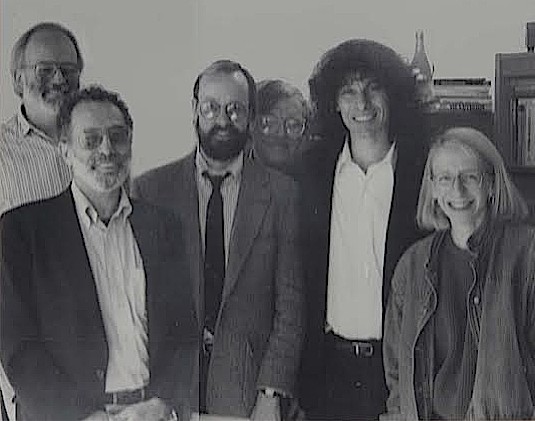This has been an unusually tough year within this peculiar family — this family of New Yorker cartoonists. Within seven months our ranks have been thinned by four: Frank Modell, William Hamilton, Anatol Kovarsky and now, this past week, Michael Crawford. Michael is remembered below by some of his cartoonist colleagues. My thanks to all for their contributions.
Note: Link here to Mr. Crawford’s New York Times obit...and here for The New Yorker‘s
Drew Dernavich:
I made this for Crawford hoping to give it to him this week, but it was not meant to be. It was the only thing I could think of to do. I tried to capture his somewhat bonkers art aesthetic, which I liked a lot, and I thought it might bring a smile to his face.
Take some pitches” is a piece of baseball chatter (which is somewhat amusing in the context of recreational softball, which made it funny, and of course he knew that) which Michael frequently repeated during the New Yorker softball games, which was one place where he really enjoyed himself.
Joe Dator:
Mr. Crawford had an absurd space-cadet sense of humor that I always admired. One of his cartoons I’ll never forget was a man walking down the street wearing a t-shirt that said “Not A Fan Of My Ex Wife’s New Boyfriend”. It’s a simple enough joke but when you look under the hood there’s a lot going on. His logic trail must have been “t-shirts … people wear t-shirts to show what they are a fan of … other people use the passive aggressive term ‘not a fan’ … a person could wear a ‘not a fan’ t-shirt”.
 [photo: In Boston, 1993 for the opening of Lines of the Times: 50 Years of Great American Cartoons at the Art Institute of Boston. Left to right: Jack Ziegler, Michael Maslin, Michael Crawford, and Anne Hall (now Anne Hall Elser), Lee Lorenz’s long-time Art Assistant at The New Yorker. Ms. Elser’s wonderful photographs of New Yorker cartoonists, including one of Mr. Crawford in a rowboat, can be found here].
[photo: In Boston, 1993 for the opening of Lines of the Times: 50 Years of Great American Cartoons at the Art Institute of Boston. Left to right: Jack Ziegler, Michael Maslin, Michael Crawford, and Anne Hall (now Anne Hall Elser), Lee Lorenz’s long-time Art Assistant at The New Yorker. Ms. Elser’s wonderful photographs of New Yorker cartoonists, including one of Mr. Crawford in a rowboat, can be found here].I’ll never forget Michael’s advice and support when I sold my first cartoon to the New Yorker. We were walking to our regular bar after softball and he explained his view of the never-ending grind that is New Yorker cartooning, and how he had batches of cartoons all ready to go in PDF form, in case he needed to send something in last minute. I remember thinking that’s a smart idea and then I remember thinking how surreal it was that I just played softball with Michael Crawford and now he’s giving me cartoon advice at Broadway and 103rd Street.
I’ll never forget the button down shirt and red jeans he wore while diving head first into home plate.
I’ll never forget his birthday party at Fanelli’s and getting tipsy with Drew Dernavich.
I’ll never forget his little red digital camera and how quickly he could get a hipshot of a play, the bench or the team on the sly.
I’ll never forget the white shirt he wore one of the last games of the season – It was clearly homemade with a sharpie and read simply “take some pitches”. No one really noticed it, but I did and I can still hear him yelling it to me nearly every time I was at the plate.
I’ll never forget to take some pitches.
While Michael Crawford was well-known as a wonderful cartoonist by a vast number of people, I’d guess that relatively few thought of him as a “sports guy” who was a terrific softball player.
But that’s the first association I have when I think about Michael, since he and I, beyond being cartooning colleagues, were, more importantly, teammates for over 20 years on the usually- hapless New Yorker softball team. So, in a season of about 10 games, we might have played ball together 200 times.
It’s said that shared adversity often brings people close together, and so, because the New Yorker softball team lost far more often than it won, Michael and I bonded and fretted more about our softball game than striving for OKs [an “OK” is the New Yorker‘s terminology for a bought cartoon] .
The team has been an odd assemblage that shows up in Central Park every Tuesday at 7pm in the summer months. It’s been made up of two distinct groups: the first, very large, composed of maybe two-dozen Twenty-Something writers, fact-checkers, etc., full of enthusiasm and team spirit, many of whom, however, possessing little knowledge of the rules of the game or an ability to run, throw or hit a ball with a bat; and the second group, much smaller, comprising “the old guys,” meaning anybody over 30, who knew the game and could play it pretty well.
Michael was in the second group, along with myself, occasionally other “oldies” like Mark Singer and Rick Hertzberg and some other editors, and I guess I could safely say that until the last four or so years, Michael was an anchor of the team.
For one thing, he was a regular. He hated missing a game and he was missed when he did. A passionate, baseball fan, he knew everything about the game, so he was a valuable tactician, as well as a sure-handed fielder and a dependable, long-ball hitter who would deliver a big hit to drive in a run in clutch situations.
On and off the field, he served as a coach and leader to those (and there were many) who were coming out to play for the first time. As soon as he arrived at the field, he’d start warmups, play catch, or start batting practice. And when the game started, he’d stay involved in it, even when we’d find ourselves on the short end of a 19-2 score after only two innings.
But Michael made it fun. When our less-proficient teammates would make errors in the field or strike out at the plate, Michael would still shout encouragement, cheering us all on. Sure, he wanted to win the game, but, he would remind me, when I got upset over all the messing up, it still was just a game.
Because often 25 people came out to play 10 positions, the coach would rotate players from inning to inning so everyone got a chance to play, but Michael was always the reliable, sure-handed first baseman. Until recently, when I’ve been pitching, I usually played second base, which meant that sometimes, after I fielded a ground ball, my throw to first might have been off line, but Michael would grab it for the out. If a batter hit a spinning pop fly between first and second base, I’d usually defer to Michael’s shout, “I got it!” because I felt that he would be less likely to muff the catch. And if Michael remembered an opposing batter’s previous hit, he might position our players to afford us a better defense.
Michael’s softball presence even extended outside himself. I remember that after he’d been playing for a few years, Michael’s grown son and daughter showed up at the games — not just to watch Dad but to play themselves. Not surprisingly, both were solid, in the field and at bat. It was also not a surprise, after some more years, that Carolita [Johnson] also came to play. Of course, being the free spirit she is, she participated in her own way, showing up on occasions after a photo shoot, wearing heels, and going out to play right field barefoot …very well.
It occurs to me now, that when Michael was at the softball game, he was totally in the moment, which, when I think about it, did not always seem the case. Off the field he seemed different. When I’d see him at normal social situations, like cartoonist gatherings, or on look days at the magazine, Michael might be operating on his own private wave length, there but, you know, not there. But on the ball field, Michael was always present with everyone else around him. Talking it up at first base, digging in at the plate, shouting encouragement to runners or batters if he was coaching at first or third. And, if he wasn’t “playing” in those roles, he would be roaming around the field taking photographs. Photos of the action. Photos of us playing. Photos of us just hanging out. Baseball photos, probably thousands of them, many of which probably wound up in his paintings and cartoons. A seamless blending of two of Michael’s greatest passions — baseball and art.
So, a salute to a teammate, and a remembrance of a Most Valuable Player.
 [Mr. Crawford, far left, with members of The New Yorker‘s softball team, celebrating an opening day victory]
[Mr. Crawford, far left, with members of The New Yorker‘s softball team, celebrating an opening day victory]



One comment